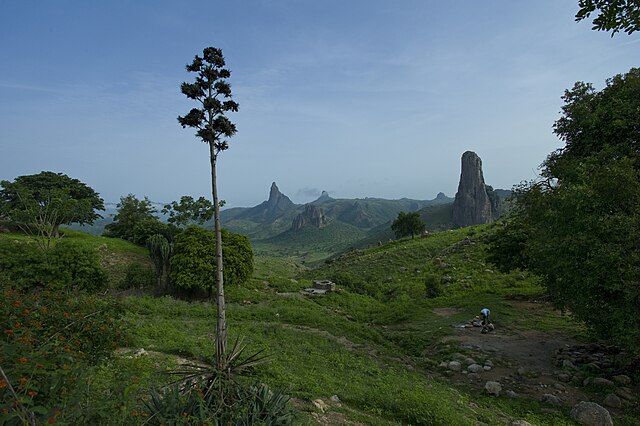On the map of Central Africa, Cameroon forms a slender triangle where the Atlantic coast meets the forests, savannahs, and mountains of the interior. Often described as “Africa in miniature,” the country’s contours contain a breadth of geography and tradition rarely found within a single set of borders. From the palm-fringed beaches of Kribi to the volcanic heights of Mount Cameroon, its terrain and heritage offer a condensed portrait of the continent’s diversity.
In the far north, the village of Rhumsiki emerges from the plain in a sudden sweep of volcanic stone. Here, jagged basalt plugs stand like watchtowers over fields and footpaths, culminating in the sharp rise of Kapsiki Peak. The French writer André Gide once called the scene “one of the most beautiful in the world,” a judgment still invoked by guides leading visitors along the ridge lines at dusk.
Far to the south, where the Atlantic moisture meets the slopes of the Southwest Region, the Limbe Botanic Garden unfolds in a green canopy. Established in 1892, the site retains traces of its colonial past while functioning as a living archive of tropical plant species. Winding paths move between medicinal plants, towering palms, and shaded groves that double as outdoor classrooms for conservation work.
The human mosaic is no less varied. More than 200 ethnic groups shape Cameroon’s cultural landscape, each with its own languages, crafts, and ceremonial practices. In the West Region, the Bamoun kingdom maintains the Sultan’s Palace at Foumban, a striking example of local architectural mastery and a repository of centuries-old regalia. Across the country, traditional dances—accompanied by drums, flutes, and call-and-response singing—serve as both artistic expression and communal record, performed during harvest festivals, royal anniversaries, and rites of passage.
Travel in Cameroon requires a measure of caution. Certain regions—the Far North, North-West, and South-West—have been affected by instability, including armed confrontations and sporadic kidnappings. In the major cities of Yaoundé and Douala, bustling markets and busy nightlife exist alongside neighborhoods where petty crime is more frequent, particularly after dark. Road travel, while offering sweeping views of forests and grasslands, can be unpredictable; heavy rains often render unpaved routes impassable, making experienced local drivers essential.
Entry is contingent on securing a visa, often via the country’s electronic application system. Health authorities recommend vaccinations against yellow fever, hepatitis A and B, typhoid, and meningitis, alongside preventive measures against malaria. Mosquito nets, repellents, and basic medical supplies are considered indispensable for rural travel.
Cameroon’s blend of landscapes, languages, and traditions places it at a cultural and geographic crossroads. For those navigating its terrain with preparation and respect for its complexities, the country offers a view into the layered histories and living cultures that define Central Africa.
Sources:
- Lonely Planet, “Cameroon Travel Guide.”
- Cameroon Tribune, “Foumban Sultanate and Bamoun Heritage.”
- Vikipedi, “Rhumsiki and Kapsiki Peak.”
- Government of Canada, “Travel Advice and Advisories – Cameroon.”
- GOV.UK, “Foreign Travel Advice – Cameroon.”
- Smartraveller, “Cameroon Travel and Health Information.”


